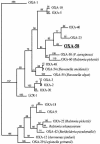OXA-58, a novel class D {beta}-lactamase involved in resistance to carbapenems in Acinetobacter baumannii
- PMID: 15616297
- PMCID: PMC538857
- DOI: 10.1128/AAC.49.1.202-208.2005
OXA-58, a novel class D {beta}-lactamase involved in resistance to carbapenems in Acinetobacter baumannii
Abstract
A carbapenem-resistant Acinetobacter baumannii strain was isolated in Toulouse, France, in 2003. Cloning and expression in Escherichia coli identified the carbapenem-hydrolyzing beta-lactamase OXA-58, which is weakly related (less than 50% amino acid identity) to other oxacillinases. It hydrolyzed penicillins, oxacillin, and imipenem but not expanded-spectrum cephalosporins. The bla(OXA-58) gene was located on a ca. 30-kb non-self-transferable plasmid. After electrotransformation in the A. baumannii CIP7010(T) reference strain, it conferred reduced susceptibility to carbapenems. The bla(OXA-58) gene was bracketed by two novel ISAba3-like insertion elements. This study describes a newly characterized beta-lactamase that may contribute to carbapenem resistance in A. baumannii.
Figures



References
-
- Afzal-Shah, M., and D. M. Livermore. 1998. Worldwide emergence of carbapenem-resistant Acinetobacter spp. J. Antimicrob. Chemother. 41:576-577. - PubMed
-
- Bou, G., G. Cervero, M. A. Dominguez, C. Quereda, and J. Martinez-Beltran. 2000. Characterization of a nosocomial outbreak caused by a multiresistant Acinetobacter baumannii strain with a carbapenem-hydrolyzing enzyme: high-level carbapenem resistance in A. baumannii is not due solely to the presence of β-lactamases. J. Clin. Microbiol. 38:3299-3305. - PMC - PubMed
Publication types
MeSH terms
Substances
Associated data
- Actions
LinkOut - more resources
Full Text Sources
Other Literature Sources
Medical

